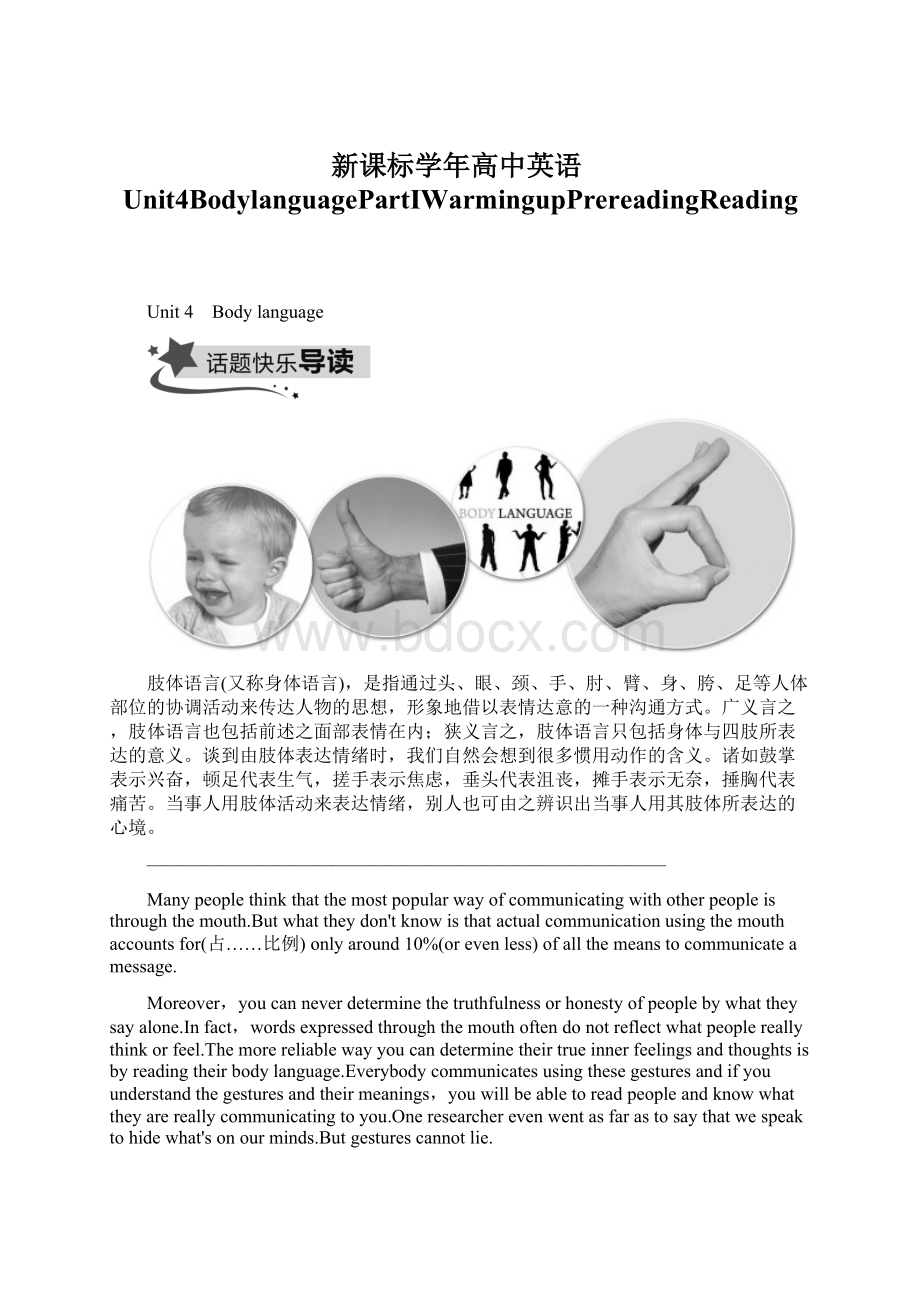 新课标学年高中英语Unit4BodylanguagePartⅠWarmingupPrereadingReading.docx
新课标学年高中英语Unit4BodylanguagePartⅠWarmingupPrereadingReading.docx
- 文档编号:7476476
- 上传时间:2023-01-24
- 格式:DOCX
- 页数:25
- 大小:875.47KB
新课标学年高中英语Unit4BodylanguagePartⅠWarmingupPrereadingReading.docx
《新课标学年高中英语Unit4BodylanguagePartⅠWarmingupPrereadingReading.docx》由会员分享,可在线阅读,更多相关《新课标学年高中英语Unit4BodylanguagePartⅠWarmingupPrereadingReading.docx(25页珍藏版)》请在冰豆网上搜索。

新课标学年高中英语Unit4BodylanguagePartⅠWarmingupPrereadingReading
Unit4 Bodylanguage
肢体语言(又称身体语言),是指通过头、眼、颈、手、肘、臂、身、胯、足等人体部位的协调活动来传达人物的思想,形象地借以表情达意的一种沟通方式。
广义言之,肢体语言也包括前述之面部表情在内;狭义言之,肢体语言只包括身体与四肢所表达的意义。
谈到由肢体表达情绪时,我们自然会想到很多惯用动作的含义。
诸如鼓掌表示兴奋,顿足代表生气,搓手表示焦虑,垂头代表沮丧,摊手表示无奈,捶胸代表痛苦。
当事人用肢体活动来表达情绪,别人也可由之辨识出当事人用其肢体所表达的心境。
————————————————————————————
Manypeoplethinkthatthemostpopularwayofcommunicatingwithotherpeopleisthroughthemouth.Butwhattheydon'tknowisthatactualcommunicationusingthemouthaccountsfor(占……比例)onlyaround10%(orevenless)ofallthemeanstocommunicateamessage.
Moreover,youcanneverdeterminethetruthfulnessorhonestyofpeoplebywhattheysayalone.Infact,wordsexpressedthroughthemouthoftendonotreflectwhatpeoplereallythinkorfeel.Themorereliablewayyoucandeterminetheirtrueinnerfeelingsandthoughtsisbyreadingtheirbodylanguage.Everybodycommunicatesusingthesegesturesandifyouunderstandthegesturesandtheirmeanings,youwillbeabletoreadpeopleandknowwhattheyarereallycommunicatingtoyou.Oneresearcherevenwentasfarastosaythatwespeaktohidewhat'sonourminds.Butgesturescannotlie.
Haveyoueverwonderedwhatitwouldbelikeifyoucan“seethrough”theemotionsofotherpeople?
Let'ssayyouaskapersonwhetherhecandoanimportanttask.Hesays“OK”.Butdeepinside,youarequestioningyourself,“Ishereallywillingtodothisjob?
”or“Doeshehavetheconfidenceinfinishingthistask?
”Youcan'tquestionhimdirectlybecausethatwouldbelikebelittlinghim.Andevenifyouaskhimthosequestions,hisreplieswillnottellyouwhathereallyfeelsorthinks.Sothemostusefulwayistoobservehisbodylanguage.Expressionslikesmiling,frowning(皱眉),pouting(噘嘴),facialreddening,sweating,toecurlingandsidewaysglancesarevisiblehintsthatcanhelpyoumakearightjudgement.
根据文章内容判断正(T)误(F)。
1.Manypeoplethinkthatthemostpopularwayofcommunicatingwithotherpeopleisthroughthehands.( )
2.Wordsexpressedthroughthemouthoftendonotreflectwhatpeoplereallythinkorfeel.( )
3.Themorereliablewayyoucandeterminetheirtrueinnerfeelingsandthoughtsisbyreadingtheirbodylanguage.( )
4.Gesturescanlie.( )
5.Expressionslikesmiling,frowning,pouting,facialreddening,sweating,toecurlingandsidewaysglancesarevisiblehintsthatcanhelpyoumakearightjudgement.( )
[答案] 1.F 2.T 3.T 4.F 5.T
PartⅠ Warmingup,Pre reading,Reading&Comprehending
Ⅰ.重点单词
1.____________vi.&vt. 迎接;问候
2.____________vt.代表;象征
3.____________n.宿舍
4.____________n.食堂
5.____________n.飞行;航班
6.____________vt.&vi.接近;靠近;走近
n.接近;方法;途径
7.____________n.面颊
8.____________vi.猛冲;突进
9.____________n.成年人;成人
adj.成人的;成熟的
10.____________adj.可能的
11.____________n.十字路口
[答案] 1.greet 2.represent 3.dormitory
4.canteen 5.flight 6.approach 7.cheek 8.dash 9.adult 10.likely 11.crossroads
Ⅱ.词汇拓展
1.__________n.陈述;说明→__________vt.陈述;说明
2.____________n.社团;联系;联想→__________vt.结交;联合
3.__________adj.好奇的→__________adv.好奇地→__________n.好奇心
4.__________vt.保护;保卫→__________n.防御;保卫
5.__________adj.主要的→__________n.大多数
6.__________vt.误解;误会→__________n.误解;误会
7.__________adj.口语的→__________adj.未说出口的;非口语的
8.__________n.雇员→__________v.雇用;使用→__________n.雇主→__________n.雇用;就业
[答案] 1.statement;state 2.association;associate
3.curious;curiously;curiosity 4.defend;defence
5.major;majority 6.misunderstand;misunderstanding
7.spoken;unspoken 8.employee;employ;employer;employment
Ⅲ.重点短语
1.closeto__________________
2.indefence__________________
3.onthecontrary__________________
4.belikelyto__________________
5.ingeneral__________________
6.保卫……以免受__________________
7.代替__________________
8.舒适;快活;自由自在__________________
9.伸出__________________
10.与……握手__________________
[答案] 1.靠近 2.保卫;防御 3.相反地 4.很可能……;有希望 5.总的来说;通常 6.defendagainst/from
7.inplaceof 8.atease 9.reachout 10.shakehandswith
Ⅳ.重点句式
1.不定式todo作后置定语
Thefirstperson________________wasTonyGarciafromColombia,closelyfollowedbyJuliaSmithfromBritain.
第一个到达的人是来自哥伦比亚的托尼·加西亚,随后紧跟着的是来自英国的朱莉娅·史密斯。
2.“动词+sb.+介词+the+身体部位”结构
TonyapproachedJulia,touchedhershoulderand_____________!
托尼走近朱莉娅,摸了摸她的肩,亲了亲她的脸颊!
3.notall“并非全部……”部分否定句式
________________culturesgreeteachotherthesameway,noraretheycomfortableinthesamewaywithtouchingordistancebetweenpeople.
各种文化背景下人们互致问候的方式不尽相同,身体接触和相互间距离的程度也并不一样。
4.theway作先行词,用inwhich/that/省略引导定语从句
Theseactionsarenotgoodorbad,butaresimplyways__________________________________.
这些行为无所谓好坏,它们只不过是文化发展的不同方式而已。
[答案] 1.toarrive 2.kissedheronthecheek
3.Notall 4.inwhichcultureshavedeveloped
Ⅴ.课文理解
1.WhereisTonyGarciafrom?
A.Britain. B.Japan.
C.Colombia.D.Canada.
2.FromParagraph2weknowthatJapanesepreferto__________whentheyareintroducedtoothers.
A.bow
B.shakehands
C.kisseachother
D.touchothers'shoulders
3.Accordingtothetext,menfromtheMiddleEastoften__________.
A.nodheadsandwavehandstogirls
B.touchothers'headswhentheyfirstmeet
C.kisseachothertwiceoneachcheekwhentheyareintroducedtoothers
D.standquiteclosetoothermenwhentheytalk
4.Fromthetext,wecanknowthat__________.
A.peoplearelikelytokeepthesamedistanceindifferentcountries
B.menfromMuslimcountriesoftenstandclosetootherstoshakehands
C.peoplefromthesameculturemaygreeteachotherindifferentways
D.bodylanguagehasnothingtodowithourlifeandcommunication
5.Fromthetext,wecaninferthatpeople__________.
A.arefacingmulticulturalcommunicationproblems
B.aretryingtomakeprogressinEnglishlearning
C.needtoknowmorepeopleandmakefriendswiththem
D.aredoingbusinesswitheachother
[答案] 1~5 CADCA
————————————————————————————
教材原文
COMMUNICATION:
NOPROBLEM?
Yesterday,anotherstudentandI,representingouruniversity'sstudentassociation,wenttotheCapitalInternationalAirporttomeetthisyear'sinternationalstudents.TheywerecomingtostudyatBeijingUniversity.Wewouldtakethemfirsttotheirdormitoriesandthentothestudentcanteen.Afterhalfanhourofwaitingfortheirflighttoarrive,Isawseveralyoungpeopleenterthewaitingarealookingaroundcuriously.Istoodforaminutewatchingthemandthenwenttogreetthem.
ThefirstpersontoarrivewasTonyGarciafromColombia,closelyfollowedbyJuliaSmithfromBritain.AfterImetthemandthenintroducedthemtoeachother,Iwasverysurprised.TonyapproachedJulia,touchedhershoulderandkissedheronthecheek!
Shesteppedbackappearingsurprisedandputupherhands,asifindefence.Iguessedthattherewasprobablyamajormisunderstanding.ThenAkiraNagatafromJapancameinsmiling,togetherwithGeorgeCookfromCanada.Astheywereintroduced,GeorgereachedhishandouttotheJapanesestudent.Justatthatmoment,however,AkirabowedsohisnosetouchedGeorge'smovinghand.Theybothapologized—anotherculturalmistake!
AhmedAziz,anotherinternationalstudent,wasfromJordan.Whenwemetyesterday,hemovedveryclosetomeasIintroducedmyself.Imovedbackabit,buthecameclosertoaskaquestionandthenshookmyhand.WhenDarleneCoulonfromFrancecamedashingthroughthedoor,sherecognizedTonyGarcia'ssmilingface.Theyshookhandsandthenkissedeachothertwiceoneachcheek,sincethatistheFrenchcustomwhenadultsmeetpeopletheyknow.AhmedAziz,onthecontrary,simplynoddedatthegirls.MenfromMiddleEasternandotherMuslimcountrieswilloftenstandquiteclosetoothermentotalkbutwillusuallynottouchwomen.
AsIgettoknowmoreinternationalfriends,Ilearnmoreaboutthiscultural“bodylanguage”.Notallculturesgreeteachotherthesameway,noraretheycomfortableinthesamewaywithtouchingordistancebetweenpeople.Inthesamewaythatpeoplecommunicatewithspokenlanguage,theyalsoexpresstheirfeelingsusingunspoken“language”throughphysicaldistance,actionsorposture.Englishpeople,forexample,donotusuallystandveryclosetoothersortouchstrangersassoonastheymeet.However,peoplefromplaceslikeSpain,ItalyorSouthAmericancountriesapproachotherscloselyandaremorelikelytotouchthem.Mostpeoplearoundtheworldnowgreeteachotherbyshakinghands,butsomeculturesuseothergreetingsaswell,suchastheJapanese,whoprefertobow.
Theseactionsarenotgoodorbad,butaresimplywaysinwhichcultureshavedeveloped.Ihaveseen,however,thatculturalcustomsforbodylanguageareverygeneral—notallmembersofaculturebehaveinthesameway.Ingeneral,though,studyinginternationalcustomscancertainlyhelpavoiddifficultiesintoday'sworldofculturalcrossroads!
译文参照
交际:
没有问题了吗?
昨天,我和另一个同学代表我们大学的学生会,到首都国际机场迎接今年的国际学生。
他们是来北京大学留学的。
我们将先带他们去宿舍,然后带他们去学生餐厅。
等待了半个小时之后,他们的航班到达,我看到几个年轻人进入了等候区好奇地四处张望。
我站在那儿观察了一会儿,然后走过去向他们打招呼。
第一个到达的是来自哥伦比亚的托尼·加西亚,紧随其后的是来自英国的朱莉娅·史密斯。
我与他们碰面并把他们介绍给对方认识,我(对看到的情景)非常吃惊。
托尼走近朱莉娅,摸了摸她的肩,并亲了她的脸!
朱莉娅看上去很吃惊,往后退了退,并抬起双手,像是防卫。
我猜想这其中可能有个大的误会。
接下来来自日本的永田明和来自加拿大的乔治·库克笑着走过来了。
当我介绍他们的时候,乔治对这个日本学生伸出了手。
然而,就在这时,永田明向他鞠躬,因此他的鼻子触到了乔治伸过来的手。
他们都向对方道歉——又一个文化上的差异!
另一位国际学生叫艾哈迈德·阿齐兹,来自约旦。
我们昨天见了面,当我进行自我介绍时,他靠我很近。
我往后退了一点,但他又靠前一点,问了一个问题,然后和我握手。
当来自法国的达琳·库隆匆忙走进门时,她认出了托尼·加西亚的微笑的面孔。
他们握手,然后在彼此脸颊上吻了两下,因为这是法国成年人在见到熟人时的礼俗。
相反,艾哈迈德·阿齐兹只是朝女孩儿们点了点头。
中东和其他穆斯林国家的男士通常和男士谈话时站得非常近,但是他们通常不和女士有身体接触。
随着我认识的国际朋友越来越多,我也了解到更多不同文化背景下的身势语。
各种文化背景下人们互致问候的方式不尽相同,身体接触和相互间距离的程度也不一样。
用口头语言进行交流的同时,他们也通过身体间距、动作和姿态等非语言来表达情感。
例如,英国人通常不和别人站得太近,也不会和刚见面的陌生人有身体接触。
不过,来自像西班牙、意大利或南美等国家的人会站在离别人很近的地方,而且可能会(用身体)接触对方。
现在世界上多数人见面都会相互握手问候,但有些文化(背景的人)会采取另外一些寒暄方式,比方说,日本人更喜欢鞠躬。
这些行为没有好坏之分,只不过是文化发展的不同方式。
然而,我发现身势语的文化礼俗很广泛,并不是一种文化中的所有人都行为一致。
但总的来说,在当今文化交融的世界,学习不同国家的习俗肯定能够帮助我们避免交往中的困难!
①Representingourschool,I'mgladtotellyousomethingabouttheseactivities.
我非常高兴代表我们学校告诉你们有关这些活动的一些事情。
②Sherepr
- 配套讲稿:
如PPT文件的首页显示word图标,表示该PPT已包含配套word讲稿。双击word图标可打开word文档。
- 特殊限制:
部分文档作品中含有的国旗、国徽等图片,仅作为作品整体效果示例展示,禁止商用。设计者仅对作品中独创性部分享有著作权。
- 关 键 词:
- 新课 学年 高中英语 Unit4BodylanguagePart WarmingupPrereadingReading
 冰豆网所有资源均是用户自行上传分享,仅供网友学习交流,未经上传用户书面授权,请勿作他用。
冰豆网所有资源均是用户自行上传分享,仅供网友学习交流,未经上传用户书面授权,请勿作他用。
链接地址:https://www.bdocx.com/doc/7476476.html


 铝散热器项目年度预算报告.docx
铝散热器项目年度预算报告.docx
